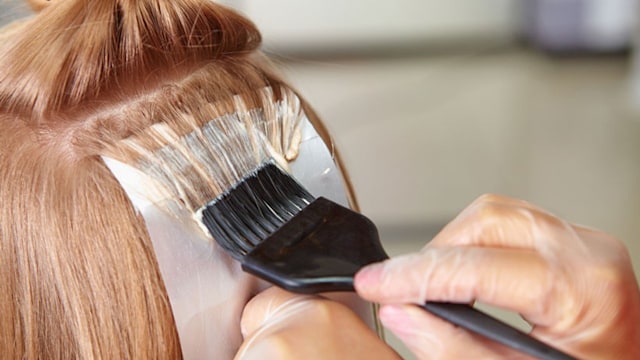Summer’s here and many of us are ready for a hair transformation for the warmer months – but while steering clear of chemicals in our food and our skincare is common enough these days, opting for organic, chemical-free hair dye is something less obvious- but it shouldn’t be! If henna is all you know about the world of natural hair colour, it’s time to read on. Because highlights, low-lights, full hair colour and pretty much everything in between can now be achieved in a gentler, less chemical way than before.
Recent studies have yet again raised the question of links between harsh chemicals in hair dye and relaxants, and cancers - specificially breast cancer risk. And while more studies are clearly necessary, the fact is, if it looks as good, is better for your hair and skin (not to mention how much healthier it is for your colourist) and doesn’t even have to cost any more, why isn’t it something we know more about?
MORE: Top ten natural beauty products
We headed down to Glasshouse Salon in Hackney, East London, an organic salon which has been dying hair without ammonia and other harsh chemicals since 2013, to get the low down on what can and can’t be achieved without the use of chemical baddies. And the results surprised us! Not only does hair lift just as brightly as is does using traditional bleach, it’s also a way less smelly process. And the organic shampoos and conditioners leave your hair feeling as squeaky clean and polished as more usual paraben and SLS stuffed products.
Olivia Crighton is the salon’s owner. Here’s what she had to say about dying your hair more gently.
Olivia runs the Glasshouse organic hair salon in London
Why should people avoid the harsh chemicals in traditional hair dyes?
We all come into contact with a large number of toxins and chemicals on a daily basis - from household cleaning products to air pollution. Our skin is our largest organ and research has shown that we can absorb up to 60% of these substances. Avoiding harsh chemical hair colour is an easy and important step to take. Ultimately, it means you’re not compromising the condition of your hair. Better condition hair means less colour fade, less breakage and a much more predictable colour result in the long run.
What are the risks of using ammonia for both client and stylist?
Ammonia is a gas and in the majority of salons it’s something that hairdressers and their clients are breathing in all the time. In order for a permanent hair colour to work, the cuticle needs to be opened and ammonia is one of the more aggressive ways of doing this. It has a very high pH and it breaks down protein and moisture in the hair, compromising condition. Balanced levels of protein and moisture are essential for a healthy head of hair and when they’re compromised, the condition suffers.
MORE: Best sunscreens to invest in now
For stylists, breathing in ammonia is obviously one of the main drawbacks, but it can also cause skin irritation - up to 70% of hairdressers suffer from work-related skin damage at some point during their career. My decision to run a “green salon” wasn’t just a client-led choice, it was for the wellbeing of my team as well.
What alternatives are there and how do they manage to get the same look without the risks?
At Glasshouse, we use Organic Colour Systems which has a significantly lower pH than most hair colour - this means we’re not taking the hair so far out of its natural condition. Protein and moisture are maintained and damage significantly minimised. In fact, our tints don’t compromise the condition at all, leaving the hair in the same state as before colouring.
It’s a great alternative to chemical-heavy hair colour and our clients are continually impressed with the results. Organic Colour Systems also use the lowest possible levels of PPD (paraphenylenediamine: the colour pigment used in permanent hair colour) - 0.06% at the lightest and 2% at the darkest concentrate. Simply put this minimises the risk of an allergic reaction both for clients and staff.
Are there any limitations to using more natural colour, such as any shades you can't achieve?
When I first started working with this brand I was pleasantly surprised by how much more I can do with it. When hair is in good condition you will get better colour results. So I set up Glasshouse Salon in 2013 with the ambition of giving clients the best possible service whilst leaving hair condition very much intact.
We prepare the hair so that the colour takes better, lasts longer and doesn’t make hair feel damaged. The best way to do this is by treating it and our 'hero' treatment product is Organic Colour Systems’ Revamp. It’s an intensive protein-based reconstructor that restores protein levels and can work miracles on even the most damaged hair. Products like Revamp allow us to work with hair that’s in optimum condition. When that’s the case, you can do so much more with it colour-wise and achieve far better results.
What about non-natural shampoos and conditioners? What should we be avoiding if we want to be as natural as possible?
Sometimes it’s more about the ingredients that are not used in your haircare than the ones that are. The brands we champion the most are formulated with high-performing organic ingredients - but they also avoid a few key chemicals. When choosing shampoo I always recommend avoiding two things. Firstly, Sodium Laurel Sulphate and Sodium Laureth Sulphate. They are irritants that can aggravate the scalp and comprise condition over time.
Second is Sodium Chloride. This is dehydrating, a common irritant and a colour-stripper. A natural-based sulphate-free shampoo is a must for healthy haircare.
